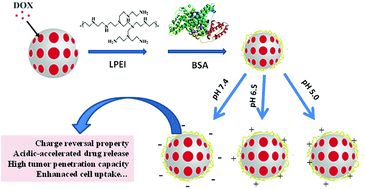pH sensitive mesoporous nanohybrids with charge-reversal properties for anticancer drug delivery
Abstract
The surface/interface state of nanomaterials plays a key role on their biomedical applications. Nanotechnology offers a versatile means to develop nanoparticles with well-defined architecture. In this study, mesoporous silica nanoparticles were firstly loaded with an anticancer drug (doxorubicin, DOX), which were then decorated with a cationic oligomer (low molecular weight polyethyleneimine, LPEI) to acquire an increased surface charge. The resulting particles were further self-assembled with negative-charged bovine serum albumin (BSA) as natural protein nanoblocks to offer surface charge tunability. The resulting mesoporous nanohybrids (MDPB) acquired charge-reversal ability, which presented negative charge under biological conditions (beneficial to biocompatibility), while displaying a positive-charged state under acidic conditions mimicking the tumor extracellular microenvironment (favoring cell uptake or tumor penetration). Furthermore, the nanohybrids not only allowed for an effective loading of DOX drug, but also accelerated its release under acidic tumor microenvironments in a sustainable way. In vitro biological study indicated that the DOX-free nanoparticles were biocompatible, while MDPB exerted good cytotoxicity against cancer cells, suggesting their promise for therapeutic delivery application.



 Please wait while we load your content...
Please wait while we load your content...